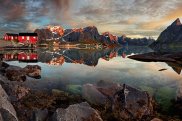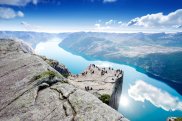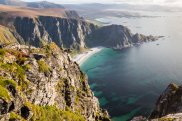
Kingdom of Norway
Kongeriket Norge
Kongeriket Noreg
Kongeriket Norge
Kongeriket Noreg
Government type Parliamentary constitutional monarchy
Area 323,781 km² (125,013 sq mi)
Population 5,562,000 inh. (2024)
Population density 17 inh/km² (44 inh/mi²)
Area 323,781 km² (125,013 sq mi)
Population 5,562,000 inh. (2024)
Population density 17 inh/km² (44 inh/mi²)
Capital Oslo (720,000 pop., 1,007,000 urban aggl.)
Currency Norwegian krone
Human development index 0.961 (2nd place)
Languages Norwegian (Bokmål and Nynorsk)
Life expectancy M 81 years, F 85 years
Currency Norwegian krone
Human development index 0.961 (2nd place)
Languages Norwegian (Bokmål and Nynorsk)
Life expectancy M 81 years, F 85 years
Dependent areas Bouvet Island (49 km² - 19 sq mi, 0 pop.)
Dependent areas Jan Mayen (377 km² - 146 sq mi, 0 pop.)
Dependent areas Svalbard (61,022 km² - 23,561 sq mi, 3,050 pop.)
* Norway also has sovereignty over the land of Queen Maud (2,700,000 km² - 1,042,476 sq mi) and the island of Peter I (156 km² - 60 sq mi) in Antarctica, subject to the Antarctic Treaty; Svalbard and Jan Mayen are non-incorporated island territories.
Dependent areas Jan Mayen (377 km² - 146 sq mi, 0 pop.)
Dependent areas Svalbard (61,022 km² - 23,561 sq mi, 3,050 pop.)
* Norway also has sovereignty over the land of Queen Maud (2,700,000 km² - 1,042,476 sq mi) and the island of Peter I (156 km² - 60 sq mi) in Antarctica, subject to the Antarctic Treaty; Svalbard and Jan Mayen are non-incorporated island territories.
GEOGRAPHY DATA OF NORWAY
Largest cities
Oslo 720,000 pop., 1,007,000 urban aggl.
Bergen 292,000 pop.
Trondheim 215,000 pop.
Stavanger 149,000 pop.
Bærum 131,000 pop.
Kristiansand 117,000 pop.
Drammen 105,000 pop.
Highest mountains
Galdhøpiggen 2,469 m (8,100 ft)
Glittertinden 2,464 m (8,084 ft)
Longest rivers
Trysilelva 747 km (464 mi) total, 233 km (145 mi) in Norway
Glomma 601 km (373 mi)
Numedalslågen 352 km (219 mi)
Gudbrandsdalslågen / Vorma 351 km (218 mi)
Tana 348 km (216 mi)
Drammensvassdraget 302 km (188 mi)
Largest lakes
Mjøsa 365 km² (141 sq mi)
Røssvatnet 218 km² (84 sq mi)
Femunden 204 km² (79 sq mi)
Largest islands
Hinnøya 2,205 km² (851 sq mi)
Senja 1,586 km² (612 sq mi)
Langøya 850 km² (328 sq mi)
Sørøya 811 km² (313 sq mi)
Kvaløy 737 km² (285 sq mi)
Ringvassøy 663 km² (256 sq mi)
Seiland 583 km² (225 sq mi)
Hitra 571 km² (220 sq mi)
Austvågøy 527 km² (203 sq mi)
ADMINISTRATIVE DIVISIONS OF NORWAY
Norway is administratively divided into 11 counties; the county of Innlandet, in the central-southern part of the country, is the largest (49,401 km²), while Akershus, which includes the suburbs of the capital Oslo, is the most populated county.Seven cities are home to at least one hundred thousand people, with Oslo having over double the population of Bergen, the second most populous urban center in Norway, while another 12 cities pass the 50,000 mark; as can be seen clearly from the second map, most of the major centers are located close to Oslo or along the southern coast.



